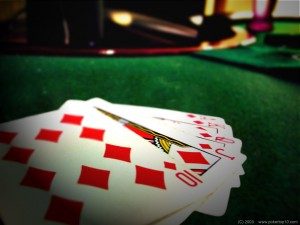 We have already examined the psychological portrait of the opponent and seen how leveling works. But in order to truly predict the opponent's behavior, we need to see the game through their eyes. This requires deeper knowledge than just the basics. We need to recreate not only their perception but also all the nuances through which they see the world.
We have already examined the psychological portrait of the opponent and seen how leveling works. But in order to truly predict the opponent's behavior, we need to see the game through their eyes. This requires deeper knowledge than just the basics. We need to recreate not only their perception but also all the nuances through which they see the world.
Strategic perception is the overall sum of how your opponent evaluates the strategic potential of various boards, situations, and so on. In which situations does your opponent think it's best to bluff? To make value bets? To check-raise, slow-play? This is somewhat different from creating a portrait, which involves a lot of generalizations. Instead, we need to use very precise, empirical methods to recreate another player's perception. This is where the skill of observation becomes paramount. We must ensure that no valuable information about our opponent is unconsciously missed.
There are two main elements of strategic perception: understanding the flow of the game and understanding board structure.
Understanding the flow of the game is a player's perception of various game flow scenarios. For example: how does your opponent interpret two bluffs in a row? How does he think you will interpret two bluffs in a row? Does he understand that after making a big bluff, there is a lower probability that you will bluff again in the next pot? All these traits form a large part of your opponent's standard model, created by playing with other poker players. It also forms his own projection; if he understands the flow of the game in the simplest way, he will often expect others to act as he does.
Understanding board structure shows how a player perceives board combinations and the relative value of each new card that appears on the board. For example, how poorly does your opponent evaluate c-betting air in a situation like J♠9♠5♦? Or in a situation like J♠8♠2♦? Or in a situation like A♠J♠9♦? And what if an ace falls? A ten? A four?
Of course, these situations must have objective value to be able to bluff or semi-bluff. By performing intensive combinatorial analysis, you can classify situations based on how good they are for bluffing in a vacuum. Everyone learns poker in different ways, and no one's perception is perfectly aligned with mathematical calculations or objective reality. Some people value certain cards more, others less; some people think they have greater fold equity in certain turn situations, and so on.
To recreate your opponent's understanding of board structure, you need to carefully observe in which flops, turns, and rivers he likes to attack, how perceptive he is in various bluff and semi-bluff situations.
Weaker players often have a naive understanding of board combinations. They do not understand the implied possibilities of semi-bluffing or bluffing by representing hands they do not have. Often such players overvalue boards with high-card-flat-flat nature, e.g., A♠5♣8♦ or K♦5♠5♣. They rarely consider the possibility of representing flush draws or straight draws.
When evaluating your opponent's strategic perception, you also need to consider the second level, i.e., how he evaluates your perception. To see this, you need to observe what kinds of hands are shown down, what types of turns you have attacked so far, and in which you have given up. Your opponent will usually always have a clearer portrait of you than you do of yourself. But a conscious, self-aware player will always have at least some awareness of the situations in which he attacks and 
in which he remains calm.
As the match progresses and history grows, it is normal to improve in strategy adjustment. If the cards are such that your created image has a low probability of bluffing, you need to increase your bluff frequency. And if the cards are such that you have bluffed or semi-bluffed several times, you should slow down the game and reduce the number of bluffs. A large part of your win rate against a decent player will be such adjustments to your own game.
What about the third level? The third level shows what your opponent thinks about how you perceive his strategic perception. Simply put, a player will adjust his game based on his own image. So, if you want to think on the third level, you need to follow your opponent's adjustments in his own board structure tendencies. You should think about which boards you called down, where he failed bluffing, where you folded, and where the opponent adjusted his game inversely.
These adjustments must be evaluated in the equilibrium of semi-bluffs. This is the standard frequency of semi-bluffs against which these adjustments are made. Initially, the standard frequency is not very exploited. But when psychology, game flow, and individual observations start to separate players from the equilibrium of semi-bluffs, their frequency becomes more exploitative.
Difficulties in poker begin when you need to positively identify these deviations and define them in the chaos of poker. Your opponent will sometimes get a lot of simple board structure hands, and you will need to conclude that he is representing better cards instead of thinking that he is just lucky and getting good cards. Being able to distinguish this is an art. And it is probably one of the last skills to learn in poker.





